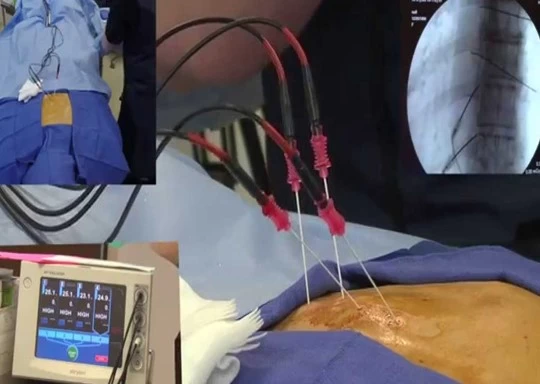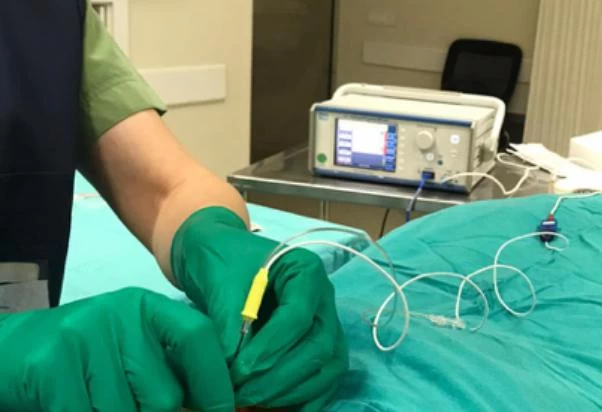
Radiofrequency Method for Pain Treatment
- Radiofrequency Method for Pain Treatment
- Basic Principles of the Radiofrequency Method
- Types of Radiofrequency
- Applications of the Radiofrequency Method
- Advantages of the Radiofrequency Method
- How the Procedure Is Performed
- Possible Side Effects and Complications
- Conclusion and Evaluation
Hello. Today, I will introduce you to the revolutionary radiofrequency method in the treatment of chronic pain. This method plays a crucial role in restoring the quality of life to our patients by effectively managing chronic pain.
Basic Principles of the Radiofrequency Method
The radiofrequency (RF) method targets nerve tissue by creating an electromagnetic field in the tissue using radiofrequency waves, producing specific currents and heat that block the transmission of pain signals. This procedure is particularly effective in controlling chronic pain.
Types of Radiofrequency
There are two main methods we use in radiofrequency treatment:
- Classical Radiofrequency Ablation (Radiofrequency Thermocoagulation-RFT): In this method, we use high-frequency currents to heat the nerve tissue to 60-90°C. This heat reduces or completely eliminates the nerves' ability to transmit pain signals.
- Pulsed Radiofrequency (PRF): Pulsed radiofrequency is applied by delivering high voltage and intermittent currents at low temperatures (maximum 42°C) to the nerve tissue. This method reduces pain transmission while preserving the structure of the nerves. PRF is particularly preferred in situations where we do not want to cause permanent damage to the nerves.
Applications of the Radiofrequency Method
Radiofrequency treatment is used for a wide range of chronic pain conditions. The most common applications are:
- Back and Neck Pain: It is an effective treatment method for spinal pain, herniated discs, degenerative disc diseases, and similar conditions.
- Trigeminal Neuralgia: In this condition, which causes severe pain in the facial region, radiofrequency treatment applied to the trigeminal nerve yields highly successful results.
- Knee and Hip Pain: It is used to control pain in joint diseases such as osteoarthritis.
- Cancer Pain: It can be used in the treatment of pain caused by tumors in cancer patients.
- Neuropathic Pain: It is an effective treatment option for pain resulting from nerve damage.

Advantages of the Radiofrequency Method
The radiofrequency method offers numerous advantages:
- Minimally Invasive: It is performed with a minimally invasive technique without the need for surgery.
- Quick Recovery Time: Patients can usually return to their normal activities immediately after the procedure.
- Long-Lasting Effect: Radiofrequency treatment provides long-term pain control and reduces the risk of pain recurrence.
- Targeted Treatment: Since we only target the nerves causing the pain, the risk of damage to other tissues is minimized.
How the Procedure Is Performed
The radiofrequency procedure is performed under sterile conditions, usually with local anesthesia. The steps of the procedure are as follows:
- Preparation: We position the patient appropriately and sterilize the area where the procedure will be performed.
- Imaging: We use imaging techniques such as fluoroscopy or ultrasound to locate the target nerve.
- Needle Placement: We guide a thin needle to the target nerve.
- Application of Radiofrequency Energy: We deliver radiofrequency energy through the needle to heat or desensitize the nerve.
- Monitoring and Completion: We continuously monitor the patient's condition during the procedure and observe the patient after the procedure is completed.
Possible Side Effects and Complications
As with any medical procedure, there are some risks associated with radiofrequency treatment. These are usually minimal and temporary:
- Infection: There is a risk of infection at the procedure site, but this risk is minimized under sterile conditions.
- Bleeding: Although rare, bleeding may occur during needle placement.
- Nerve Damage: There is a risk of permanent nerve damage if the nerve is accidentally injured.
- Allergic Reaction: Allergic reactions to the anesthetic agents used may occur.
Conclusion and Evaluation
We prefer the radiofrequency method because we see it as an effective and reliable method in the treatment of chronic pain. Its minimally invasive nature, quick recovery time, and long-term pain control make it an attractive option for both us and our patients.
If you are also seeking relief from chronic pain, you can consult an algology specialist to get detailed information about radiofrequency treatment and assess whether it is suitable for you.
Wishing you healthy and pain-free days.

Assoc. Prof. Dr. Tülin Arıcı
Algology Specialist





